Seven four-furrow ploughs on test
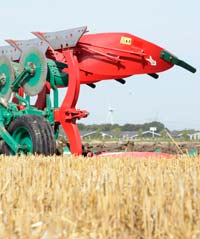
Buying a plough can be a complex and drawn-out affair. Whether you choose a make because you’ve always had one of them, or because of your soil type or for the back-up, there are always a number of variables to consider.
Farmers Weekly teamed up with Netherlands magazine Boerderij alongside German title Top Agrar and La France Agricole to test seven, four-furrow, mounted reversible ploughs, all with hydraulically adjustable working width.
This is the type of plough most commonly sold in the Netherlands, and also has a high number of sales in the UK, too, for farmers with tractors between 100 and 175hp.
Test ploughs were each fitted with a depth wheel, skims, all-round furrow knives and disc coulters on the last furrow. Two identical Deutz-Fahr M640 tractors were used throughout testing.
All manufacturers were asked to deliver ploughs with the most suitable body for the polder clay of the test farm.
Ploughs tested
Thirteen manufacturers were asked to take part but some brands aren’t available in the UK. Equally, some that aren’t available in Holland haven’t made it into the line-up. However, we did invite Gregoire Besson to take part, but they were not able to.
Kuhn, Lemken, Overum, Pottinger, Rabe and Vogel and Noot all delivered ploughs to meet the specification requested.
Kverneland Benelux was unable to get a plough to the test facility and, given this marque’s popularity, it was impossible not to have one in the test, so Boerderij hired a similar-spec’d model from a farmer. It differed in two respects – the hired Kverneland had disc coulters on each furrow rather than trash boards and leaf-spring protection instead of shearbolts.
All manufacturers had the opportunity to adjust their ploughs to the field conditions.
The seven listed here are all available in the UK and Europe.
The test itself
We tested the ploughs for five things: Ease of adjustment, furrow width adjustment, overall construction and, most importantly, ploughing quality, all carried out by a team of ploughing experts and agricultural engineers.
Kuhn
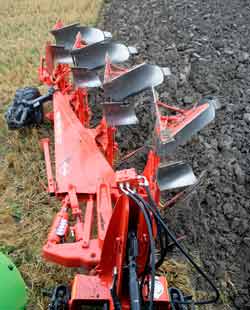 |
|---|
| Skim depth adjustment is pretty simple on the Kuhn. |
Model: Vari-Master 122
Plough Body: P6
Price tested version: £15,909
EASE OF ADJUSTMENT
Score 4.5
Because of the large number of hydraulic cylinders and parallelogram design, a quick look at the 74-page manual is required during adjustment, where everything is explained clearly.
Optional hydraulic front-furrow adjustment is an expensive option. Change to track width is cumbersome, meaning the whole turnbuckle adjuster has to be altered.
Kuhn also gets some plus points for the simple skim-depth adjustment.
HYDRAULIC ADJUSTABLE WIDTH
Score 4.5
The width cylinder can be clearly read from in the cab, and operation is straightforward. But it’s a pity it’s only in inches and not in centimetres.
CONSTRUCTION
Score 3
The Kuhn is a robust and nice-looking plough with a clean finish. Unlike other manufacturers, Kuhn places the vari-width parallelogram in the main beam, instead of to the left of the beam.
Hoses also run through the main shaft but could get pinched when turning. The shock absorber for the wheel is overly strong, meaning there’s a couple of seconds of waiting. The depth wheel had a tendency to drag when the plough is running at maximum depth.
PLOUGHING QUALITY
Score 4
Surface levelling and soil inversion were perfect, but furrow packing isn’t quite so good, with occasional holes noticed between furrows. Width at the bottom of the furrow was 16inches (40cm). Overall the Kuhn reversible scores high for quality.
Kverneland
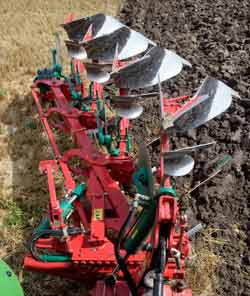 |
|---|
| The Kverneland was the only one to turn over either way. |
Model: EG 100
Plough body: 28
EASE OF ADJUSTMENT
Score 3.5
Kverneland falls in the middle in terms of how easy it is to adjust.
For the line of pull, the turnbuckle adjuster (which is secured on one side by a nut) has to be loosened, then turned, then the nut has to be done up again. The height of the skims can be adjusted independently and there are notches to help.
Changes to front-furrow width are via a large turnbuckle and sliding plate, and the nuts for angle adjustment are locked by a small rod which works well.
VARIABLE WIDTH ADJUSTMENT
Score 4
Variable working width changes are fast and direct, and visibility is good from the cab on both sides of the frame. The fact that the indicators do not show different depths after turning over is disappointing.
CONSTRUCTION
Score 4
Robustly made and good-looking, the Kverneland is a combination of steel plates, cut and forged parts.
The depth wheel is mounted far to the side, unlike the others, and could prove to be an obstacle. The manual is good but lacking stickers on plough itself. Welding quality is perfect.
It’s also the only plough that can turn with the plough bodies over or under the frame – unique but needs a lot of spannering to switch.
PLOUGHING QUALITY
Score 3.5
Furrow packing and surface levelling was adequate but soil inversion wasn’t as good as the others. The plough body doesn’t push the furrow enough for inversion. At the end of the test field, where soil had less clay content, inversion was a lot better.
Lemken
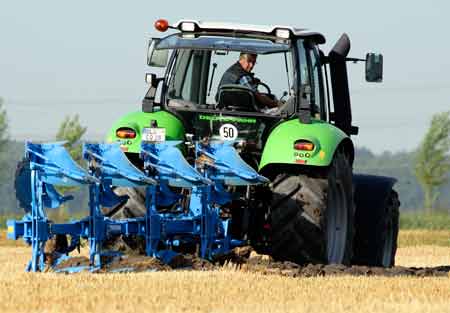 |
|---|
| Lemken plough was easy to adjust in all areas. |
Model Vario Opal 7
Plough body W 52
Price tested version £15,626
EASE OF ADJUSTMENT
Score 4.5
Very easy to adjust in all areas. Line of pull is adjusted through a simple turnbuckle in the parallelogram and works flawlessly.
Turning the plough bodies over or under the frame also works well. Front-furrow width is done via a parallelogram – better than moving the plough body sideways on the headstock.
Quick-adjust system for skims is a time-saver and there are no bolts or pins to lose.
VARIABLE WIDTH ADJUSTMENT
Score 4
Plough adjusts more quickly when narrowing than widening but, overall, the Lemken performs well in this area. It also has the narrowest possible ploughing, just 6.7inches (17cm).
CONSTRUCTION
Score 4.5
Everything indicates the Lemken is well-made.
A lot of the parts are bolted together rather than welded, and all grease nipples have red covers. Hydraulic rams are kept compact and hoses are all nicely protected (not in main shaft).
The depth-wheel mechanism seems over complicated with lots of joins and a chain that releases the main lock and catches the depth wheel when turning.
PLOUGHING QUALITY
Score 4
On the clay ground, soil inversion was good with no trash visible but furrow packing was average with surface levelling not so good, resulting in a furrow which wasn’t completely broken. On the lighter clay land, ploughing quality was better.
Overum
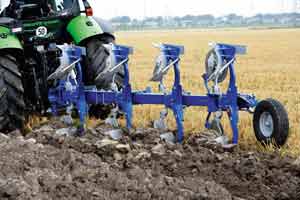 |
|---|
| Surface levelling was good. |
Model Vari Flex CX
Plough body XL
Price tested version £14,517
EASE OF ADJUSTMENT
Score 4
Line of pull is difficult to adjust and instructions aren’t in the manual.
Turnbuckles for over- and under-turning are tricky to reach. Skims are easy to change both in width and depth, and the disc coulters have notches for depth.
Depth wheel adjustment is good via handles which lock in place through an internal ball-spring system. Overum was the first to introduce this.
VARIABLE WIDTH ADJUSTMENT
Score 4
Cut-out graduation is clear and looks as if it would last, but needs more numbers.
CONSTRUCTION
Score 4
A simple and slender plough, the Overum compares in weight to the other ploughs.
Most parts are bolted. The outer edge of skims is rounded to prevent trash blockages. It has a compact combined memory/vario cylinder and the depth wheel is cleverly but simply engineered.
Can change from over and under turning after some adjustment.
PLOUGHING QUALITY
Score 4
Surface levelling good but furrow packing average with too much space between furrows. Soil inversion good, despite narrow plough bodies. On lighter soils performed better.
Pottinger
 |
|---|
| Dual depth wheels weren’t ideally suited to the clay soil. |
Model Servo 35 Plus
Plough body 46W
Price tested version £18,220
EASE OF ADJUSTMENT
Score 3.5
Line of pull and front furrow adjustments are straightforward, as are skims (but they lack width adjustment). Adjustment of depth wheel a big minus – the height adjustment isn’t lockable. Over and under changing is done via a handle which turns 180 deg.
VARIABLE WIDTH ADJUSTMENT
Score 5
Clear and accurate graduation which is easy to read in the cab. Line of pull doesn’t change with adjustment.
CONSTRUCTION
Score 3.5
Finish is high-quality, mostly robotic welded with cast headstock.
Hydraulic hoses run through hollow main shaft. Dual depth wheels not suited to clay, with soil getting stuck between the frame and the wheels – a minus for an otherwise very well put-together plough. Pottinger says there are other depth wheels available.
PLOUGHING QUALITY
Score 3
Plough had universal plough bodies rather than clay bodies, meaning quality wasn’t as good as it could have been.
Furrows weren’t visible, and there were some dips between furrows. Surface levelling and soil inversion were OK, and bottom furrow width was 18.5 inches (47cm).
Maybe faster ploughing gives better results, as the manual stated 4.4mph as an ideal speed.
Rabe
 |
|---|
| The Rabe turned the furrows well and left no trash. |
Model Raven V1500
Plough body BP 365P
Price of tested version £17,268
EASE OF ADJUSTMENT
Score 3
Overall, it’s tricky to fathom and we’re still guessing how to adjust the line of pull; perhaps it’s integrated with the frame swivel cylinder.
Changing from over to under is particularly difficult with no bolts or handles, only an eye which needs another tool. It’s difficult to guess the correct depth of skims when adjusted, too.
VARIABLE WIDTH ADJUSTMENT
Score 5
Ploughing quality is consistent throughout the changes in working width and graduation is easy to read in the cab.
CONSTRUCTION
Score 3.5
Uncomplicated-looking plough, with forged headstock.
Because the plough is dipped, not sprayed, there are large droplets of paint visible. Hydraulic hoses have recoil valves, so the cylinder doesn’t move during ploughing and the memory cylinder is completely separate from the vario cylinder.
PLOUGHING QUALITY
Score 4
Furrow packing best in test, with almost no holes visible between furrows. Surface levelling good and soil inversion excellent. Plough body turns furrow well with no trash.
Vogel and Noot
 |
|---|
| The Vogel and Noot was easy to adjust despite a lack of stickers. |
Model Plus XM 950 Vario
Plough body WXL 30
Price tested version £17,442
EASE OF ADJUSTMENT
Score 4.5
This Austrian plough is straightforward to adjust, despite lack of stickers.
Front furrow and changing from over- to under-turnover is good. Depth adjustment is by bolt and holes and width is easy to adjust. Depth wheel adjustment is by hand and its drop rate can also be tweaked, too.
VARIABLE WIDTH ADJUSTMENT
Score 4.5
Ploughing is consistent during working width and graduation is adjustable and easy to read.
CONSTRUCTION
Score 4
Simple plough with a lot of pressed and bolted parts with the main beam reinforced with bolts. Parallelogram situated to the side of the frame.
Combined memory/vario cylinder with two cylinders, the memory one with more stroke to allow the plough to pivot more to the inside during turnover, meaning the wheel doesn’t hit the soil.
PLOUGHING QUALITY
Score 4
Together with Kuhn, Vogel and Noot has the best ploughing quality, with better furrow packing and no dips and ridges. Soil inversion is perfect and there’s no trash.
What plough qualities were the testing team looking for?
EASE OF ADJUSTMENT
For most, the line of pull only has to be adjusted once, especially when the same tractor is being used for most of the ploughing, and it’s only when field conditions change that things like skims and disc coulters have to be fiddled with.
Because of this, ploughing quality has three times the weighting in this particular test. After all, commented one of the judges, he’d rather have a plough that was cumbersome to adjust with good ploughing quality; the aggravation of adjusting a plough is forgotten in a week, bad ploughing haunts you all year.
Most of the ploughs tested adjust the front furrow width by moving the plough body sideways via a sliding bar in the headstock. The line of pull is then changed by means of the usual nut and bolt affair.
But Kuhn, Pottinger and Lemken have combined the adjustment of both line of pull and front furrow width by using a clever parallelogram arrangement with multiple pivot points, meaning any adjustment in the furrow width should automatically result in a change in the line of pull.
In all cases, having a quick look at the manual was essential, as stickers didn’t provide enough information. Although no manufacturer had the perfect solution, Lemken, Kuhn and Vogel and Noot were the most straightforward.
Lemken was the only one to have a quick-adjust system with no bolts for the skims, whereas Kuhn and Vogel and Noot had skims that were easy to adjust, in all directions.
The judging team |
|---|
| Both adjustability and ploughing quality were tested by Dutch ploughing experts and arable farmers Flip Blom, Jan Bom and Sybren de Lange, who are responsible for cultivations at the host farm, PPO Lelystad. Construction and build quality was judged by three agricultural engineers: Henk Lemand, former engineer at the Evers tillage machinery company in the Netherlands; Johannes Ballast, an engineer and importer of machinery; and Marinus Langebeeke, former manager of Lely Industries, Holland. |
Although having hydraulic width adjustment commands a significant premium, it has distinct benefits, for example for a bend which needs straightening, finishing ploughing and keeping the furrow straight in hilly or changing soil conditions.
When the plough encounters more resistance, either going uphill or in heavier soil, the plough will always have a narrower working width than when going downhill or in light soil. Disadvantages include the price, and more wearing parts to go wrong.
An important factor when changing the furrow width is that the overall alignment remains the same and in this area, all ploughs performed well. However, the control of the hydraulic cylinder for furrow width on the Lemken has room for improvement, as it works faster when narrowing the width than widening, whereas each of the other ploughs react equally, meaning it’s possible to adjust the width without having to watch the plough itself.
CONSTRUCTION AND BUILD QUALITY
The overall design of the Lemken, Kverneland and Kuhn models seem the most robust.
Some ploughs are predominantly made of cast iron and forged parts, like the Kverneland, whereas others adopt more of a machined steel approach with plates welded together. Both construction methods have comparable strength.
The variable working width linkage design of the Kuhn, Pottinger and Lemken show good engineering, whereas the depth wheel of the Overum is clever, too.
The design of the depth wheel on the Lemken seems over-complex, and the depth wheel of the Pottinger is prone to soil sticking.
OBSTACLE TEST
Despite Dutch soils having fewer stones than here in the UK, it was still important to test the plough leg protection of each of the ploughs tested.
To test how well shearbolt protection worked, we buried a concrete floor panel at a depth of 20cm (8inches) having asked each of the manufacturers beforehand if they would object to this test. Because we borrowed the Kverneland, we didn’t carry out this test on that plough.
The obstacle test didn’t show any major differences, and all shear bolts functioned correctly when the concrete was hit. Kuhn scored a plus, as this was the only plough that used a traction bolt rather than a conventional shearbolt, and replacement was straightforward as the leg could be pushed back against a bracket.
PLOUGHING QUALITY
The ground was reasonably dry for the test, resulting overall in good ploughing conditions. The plough depth was 20cm (8inches), the same depth the fields are usually ploughed for normal cultivations, and working speed was 3-4mph (5-6.5kph).
The performance of each plough was judged on surface levelling (all furrows at an equal height), furrow packing (no visible holes) and soil inversion (a totally inverted furrow with no trash). In addition, the width at the bottom of the furrow was measured.
The test field was divided into two areas – one for setting up the plough correctly and one for the six passes of test ploughing. This allowed each piece to be judged clearly.
The ploughing quality of the Vogel and Noot, Kuhn, Lemken, Overum and Rabe were good,. However, Kverneland and Pottinger didn’t score quite so highly on soil inversion, with some trash still visible.
An important point to note is that because the test was carried out on medium heavy clay, some ploughs may perform better on lighter clay and sand, which is the case with the Kverneland, resulting in better inversion.
WEIGHT
Ploughs were weighed on the calibrated PPO-Lelystad weighbridge. Kuhn was the heaviest plough with 1800 kg and Overum was the lightest at 1530kg – a difference of 680kg.
Because mounted pieces of kit act like a lever when lifted, weight from the front axle is transferred to the rear axle. Therefore, a longer plough that isn’t mounted close to the tractor takes more weight from the front than a shorter, more compact plough. The weight transfer was measured by driving the tractor with the plough onto a scale.
The test tractor had 1400kg of front weight on the front linkage. Without a plough, the weight at the front axle was 4900kg.
The ploughs tested took between 1550kg and 1950kg off the weight on the front axle when lifted, meaning between 2950kg and 3350kg remains, reinforcing the need for a good set of front weights for both traction in the field and safety on the road.
The weight on the rear axle variedbetween 6600kg and 7200kg (a 300kg difference per tyre). Rabe puts most weight on the rear axle, Overum the least – meaning that tyre pressure can be 16psi for the lighter Overum and 19psi for the heavier Rabe, according to the Michelin guide.
fwmachinery@rbi.co.uk
Co-operation |
|---|
| The plough test was carried out at the University of Wageningen’s research farm, PPO-Lelystad, on a 20ha (50 acre) plot of cereal stubble with a Dutch polder clay soil type and a clay content of between 30-35%. SDF Holland supplied two identical Deutz Fahr M640 tractors (165hp). Michelin supplied identical Michelin Omnibib 580/70 R38 rear tyres and 480/70 R28 front tyres. |

